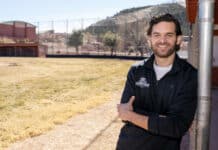The days of the flip phone are gone.
Nowadays, just about everyone has some type of smartphone — basically a mini computer in their pocket or purse. And with them come an ever-increasing demand for more data and improved coverage.
In order to keep up with that demand in Sedona, Verizon Wireless is seeking to install a monopine tower designed to look like a pine tree, the first of its kind in West Sedona other than those on Airport Mesa.
The tower is being proposed for 75 Kallof Place, the location of Shephard-Wesnitzer Inc., an engineering firm off State Route 89A behind Natural Grocers. It was noted that there is no housing within 300 feet of this location.
Verizon representative Nancy Smith appeared before the Sedona Planning and Zoning Commission on July 3, as part of a Conditional Use Permit request by the wireless company. The Sedona Land Development Code states that new and replacement antenna-supporting structures intended for commercial use shall obtain approval of a CUP. The request passed unanimously.
The next step is for Verizon to submit a building permit for review and approval. It will include information such as structural calculations and electrical plans. But, there are no more public process steps.
Verizon agreed to decrease the tower from 75 to 70 feet in height to meet the new standards in the recently revised Land Development Code. In addition, the company has said it will allow up to two other carriers to co-locate on the tower, which eliminates the need for additional cell towers in that area.
A letter of intent from Young Design to the city, dated Feb. 6, explains the need for the tower.
“The purpose of the proposed site is in response to many consumer complaints in the area that they have experienced dropped calls along with minimal capacity at best for data use issues as well as to address the necessary off-loading of the Sedona Airport cell site that Verizon has, which is currently over the capacity and not functioning correctly,” the letter states.
Smith said Verizon chose this property because of the need, because it does not border residential properties, and because it is far enough from the highway that it may not be as noticeable.
“The data capability is really about the fact that everybody’s phone does much more than it ever has and being more of a computer than just a phone,” she said. “It’s a capacity issue and [current service] isn’t keeping up with the current demands. Therefore [Verizon] receives complaints.”
She went on to say, “It’s not just current data needs — they’re looking at what’s going to happen in the near future. Because of that, the airport site is overloaded, which means it’s not handling the traffic that’s on it.”
When it comes to cellular towers, a city’s hands are often tied due to federal laws in terms of what it can deny, which was pointed out by Planning and Zoning Commission Chairman Marty Losoff prior to the vote.
“We’ve had many, many meetings on this subject and realize we’re limited as to what we can and can’t do,” he said.
Ron Eland can be reached at 282-7795 ext. 122, or email reland@larsonnewspapers.com


















